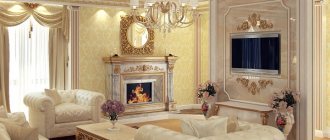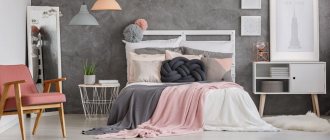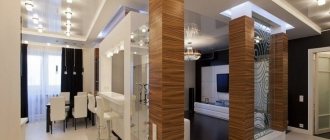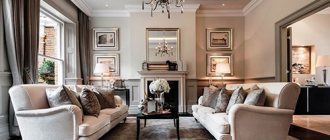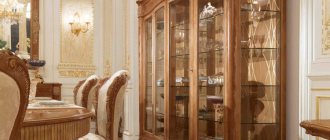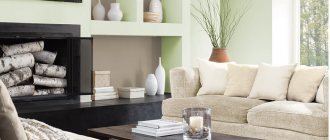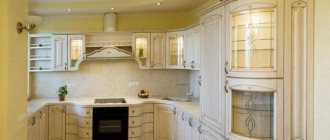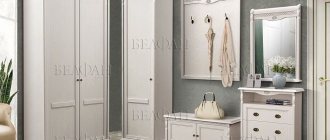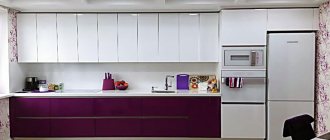The classics constantly acquire new features, and thanks to this they remain relevant to this day. The interior in a classic style is quite practical, but not prim and creates the impression of elegance. The inherent laconicism of the classics will not allow the room to be cluttered with unnecessary objects and decorations. If you have a desire to furnish your living space in the style of modern classics, first familiarize yourself with the basic components of this style.
Bedroom design in turquoise color
The combination of classic and modern will look winning
The design of the living room is made in the same style
Characteristics
Each era and country had its own ideas about the traditional classical style. Therefore, there are several such styles - antique, gothic, renaissance, baroque, modern.
Almost always, when they talk about classicism, they mean a monumental and representative style with an abundance of expensive wooden furniture, expensive fabrics, complex and lush draperies, elegant and expensive wall and floor decoration, spacious rooms with high ceilings, stucco moldings, bas-reliefs, columns, expensive paintings and works of art.
Classicism in the traditional sense emerged in the art of interior design at the beginning of the twentieth century. To some extent, classicism is a counterbalance to modernity with its abundance of non-functional decorative elements and excessive pomposity. Classicism is characterized by restraint and rigor, as well as significant simplicity of lines (especially when compared with Baroque, Renaissance, and Art Nouveau).
Points of contact
The classic interior style, formed back in the 16th-18th centuries, does not lose its relevance today thanks to its aristocracy, sophistication and rigor. It absorbed the best of Baroque, Rococo and Empire style. There is no place for artificial and cheap materials. Accessories are selected with an emphasis on historical or cultural value.
The modern style or contemporary arose much later - in the second half of the twentieth century. He took the focus on a functional and practical space without frills. Minimalism, modernism, high-tech and eco-style contributed to its formation. Unlike the classical trend, contemporary art allows the use of inexpensive artificial materials, simple and functional furniture, and minimalist decor.
Despite the difference of almost four centuries, these two directions still have a lot in common: pastel light shades, a single color scheme, clear lines, a desire for symmetry, elegance and space. The unifying features will become the starting points for style combinations.
Style transformation
Classic never goes out of style. The basic principle of modern classics is discreet elegance. This style combines the best ideas of many eras and trends in interior design. Modern classics in the interior are associated with prestige and wealth (one might say luxury). People who choose neoclassical interiors are characterized as successful and sensible adherents of traditions.
Neoclassicism in a modern interior is a compromise between the principles of classicism and the realities of today. Classic in the traditional sense of style requires significant investments, expensive materials, sophisticated finishes, very spacious rooms, luxurious furniture and works of art. Therefore, the classic interior in modern houses and apartments is a discreet stylization on the theme of the classics.
Furniture in neoclassical style
It is impossible to save on furniture when decorating such an interior. Preference is given to models made from natural materials, with a base of the correct geometric shape, rounded backs of sofas, armchairs, curved legs of poufs, chests of drawers, and tables raised above the floor. There should not be a lot of furniture in such an interior, since it is necessary to save more free space, that is, its functionality and capacity are also important.
The facades of large objects - living rooms, kitchen units, cabinets - must necessarily reflect light and include transparent glass planes, creating additional volume in the interior. In addition, decoration and decor of furniture from
- expensive textiles;
- genuine leather;
- forged elements.
If a dining room or dining area is designed in the living room or spacious kitchen, then chairs with high backs must be present. The neoclassical style bed is large, massive, on carved legs, with a high headboard, upholstered in expensive fabric.
The wall for the living room should include display modules - pencil cases for books, sideboards for dishes. In small apartments they can be replaced by sets with matte facades, complemented by mirror inserts.
It is not enough to choose the right furniture; it is also important to place it correctly. Only professionals in the field of interior design can take into account every detail while maintaining the style.
Features of neoclassicism
Main characteristics of modern classics:
- spacious and bright rooms;
- use of natural materials, especially natural wood;
- furniture of traditional restrained forms, without unnecessary decorations and carvings;
- simple form of furniture, the presence of mirrors, glass;
- absence of eccentric elements of furniture and decor;
- discreet atmosphere, but not a minimalist interior;
- the presence of elegant decorations - paintings, lamps, sconces, sculptures, vases, clocks.
A combination of classic and contemporary
The author of the project is Victoria Lazareva. Photo: Alexander Shevtsov
The author of the project is Victoria Lazareva. Photo: Alexander Shevtsov
The owners of this apartment wanted something bright and extraordinary. The author of the project, Victoria Lazareva, created for them an interior filled with color and mysticism, in which she combined the traditions of English classics and the features of modern contemporary. A unique atmosphere is created by objects of art invented specifically for this project.
Special requirements
The main requirement for a room in which it is planned to decorate the interior in a neoclassical style is the presence of a sufficiently large area and a ceiling height of at least 3 m. In a small room (less than 20 m2), all the beauty and elegance of the interior will simply be lost.
The second requirement is large windows. Not necessarily modern panoramic ones, but not the small and narrow “loopholes” that are sometimes found in Stalin buildings.
The third requirement is a sufficient width of the room. Preferably from three and a half meters.
We decorate every room
See alsoSoviet interior
Hallway
Decorating a hallway in a neoclassical style is not that uncommon. The corridor meets and sees us off, and therefore sets the tone for the entire apartment. The center of the hallway is the door or mirror, around which the rest of the composition is formed. In a modern layout, the hallway flows smoothly into the living room.
Design Tips:
- A mirrored wardrobe will save space and be a good solution for a small corridor.
- If space allows, it would not be superfluous to place an armchair or a couple of poufs or a coffee table here.
- The design of the hallway should be consistent in color and materials with the rest of the rooms.
The design of the hallway should be consistent in color with the rest of the rooms.
The hallway welcomes and sees us off, so the design needs to be thought out correctly
A painting on the entire wall will look very beautiful.
See alsoClassic in the interior
Bedroom
For a bedroom, it is better to choose a calm interior without flashy decorative elements. Monochrome thick curtains with a little will fit harmoniously. The compositional center is the head of the bed, on both sides of which stands are often placed. Often photo wallpapers are used to visually expand the space.
Wallpaper is perfect for decorating bedroom walls
Very often, cabinets are placed on both sides of the bed
For a better choice, choose a calm design
See also Art Deco in the interior: colors, features, photos
Kitchen and living room
The laconic design of a modern classic makes the kitchen look more like a dining room than a place for preparing food. It is also noteworthy that the living room and kitchen are usually located in the same room, divided into functional areas. The design is characterized by the use of:
- glass surfaces;
- built-in electrical engineering;
- comfortable, upholstered furniture;
- wide lighting area.
This design makes the kitchen look like a kitchen
If the design of the kitchen and living room are similar, they are simply divided into functional zones
See alsoFusion style in the interior - combining incompatible things
Bathroom
Neoclassical bathrooms are characterized by discreet elegance. The materials imitate precious metals, and tiled mosaics are also used. A few small paintings or shelves with decorations will make your stay in the room more pleasant, and spotlights will add a modern accent to the interior.
See alsoLight colors in modern design
Principles for choosing furniture
With a neutral wall color, cabinet furniture plays first fiddle in the design. Cabinets and cabinets, tables and chairs in any classic style should be made of solid wood (not pine) or covered with veneer. The natural beauty of wood cannot be replaced by anything. It is highly undesirable to use furniture with a plastic coating that imitates the texture of natural wood. Elements of high-tech style are completely unacceptable: glass tables and metal furniture, especially with shiny nickel-plated elements.
Sofas and armchairs should be of a simple, laconic shape, with smooth curves, not too bulky, and not pretentious in shape. Furniture can be quite massive on short modern legs and in a traditional classic style: compact armchairs and sofas on tall wooden legs of a simple shape. Upholstery in discreet colors; it is possible to use striped furniture fabrics for traditional furniture with legs.
Winning alliance
The symbiosis of classics and contemporary gave rise to a new independent direction in design - neoclassicism or modern classics, which is in great demand today. It interprets the straightforwardness and simplicity of modern design while maintaining the luxury and sophistication of a classic style. Such interiors have a lot of space, light and air.
Fans of bold experiments, bright palettes and unusual combinations are unlikely to appreciate neoclassics. It is more likely for those who:
- loves rigor and tradition, but strives to keep up with the times,
- wants to emphasize the status and nobility of the interior without being too old-fashioned,
- dreams of a soft, calm and elegant atmosphere without daring designer impromptu,
- plans to create a functional and discreet interior with a touch of history.
Color spectrum
Classic means restrained light colors: white, beige, gray, golden, coffee, sand, light brown. Sometimes pastel blue, salad, lemon, milky tones. Dark colors are not used. Aggressive colors are not used: red, coral, orange. Cherry - only in accents. It is not customary to decorate a classic interior in lilac and purple tones. Golden color can be used in decorations.
The floors are natural colors of wood or stone. No unnatural colors - green, blue, red.
The ceiling is always traditionally white.
Classic with modern details
The author of the project is Alexandra Helminskaya-Leontyeva. Photo: Dmitry Chebanenko
The author of the project is Alexandra Helminskaya-Leontyeva. Photo: Dmitry Chebanenko
The owners of this Moscow apartment, an adult couple, initially wanted a purely classic interior. But in the process of work, it turned out that they were uncomfortable staying within the confines of one style. Then the author of the project suggested diluting the design with modern details. As a result, the interior looks calm, restrained and relevant.
Finishing materials
A characteristic feature of the classic style is the absence of plastic coverings, glass countertops, metal furniture, counters and structures made of nickel-plated metal.
Floor
It is difficult to imagine a modern classic interior without parquet. In this style, budget linoleum, artificial laminate, and just a board, even from exotic woods, are inappropriate. The parquet should not be too dark or light straw. Only natural wood tones of medium color saturation.
A possible option is natural stone or tiles. Such a covering is sometimes installed in houses with a “warm floor” heating system. It is not advisable to use black stone.
Walls
Luxurious Venetian plaster is quite appropriate for walls. Painting with water-based paints is not recommended. Embossed non-woven wallpaper with painting, smooth or striped vinyl look good. There should be no drawings, flowers, or even larger abstract graphics on the wallpaper. Under no circumstances should loft elements (brick walls) or textured plaster be used in a classic interior.
Walls are often decorated with moldings (cornices). You can use imitation columns with moderately complex stucco at the top.
In traditional classical styles, walls were often covered with painted white panels, decorated with moldings or milling in the form of panels. Nowadays this design is rarely used. Do not use fabric covering panels or fabric wallpaper, especially with a pattern.
Ceiling
The ceiling in classic interiors is white - traditionally painted or stretched. Stretch ceilings should be matte, in no case glossy or satin. Sometimes it is appropriate to place a stucco rosette on the ceiling under a chandelier (without gilding!)
If the ceilings have two or three tiers, they should be of a simple shape; the best option is to follow the shape of the ceiling. There should be no bright colors, mirrors, dark inserts, photo printing, dark canvases, or Swarovski crystals. Diffuse lighting of the ceiling or a “floating” ceiling is possible.
Combination of classic and modern style
Authors of the project: Alexander Kutsenko, Yulia Mikhailova. Photo: Vitaly Nefedov
Authors of the project: Alexander Kutsenko, Yulia Mikhailova. Photo: Vitaly Nefedov
The author of the project, Yulia Mikhailova, says: “We were faced with two main tasks: to preserve the feeling of air in the space and to make the high-status interior in tune with global fashion trends. We decorated the open space of the main zone with classic decorative elements, but in a modern, laconic interpretation. We complemented the bright black and white contrast in the decoration with fresh flowers and walnut root furniture. This is how the right balance was found between classic and modern style.”
Decor and lighting
Lighting fixtures play a very important role in creating a classic interior. The presence of a chandelier and sconce in neoclassical style is mandatory. The most traditional ones are chandeliers and sconces with gilded fittings and bronze fittings. Simple painted fittings are allowed, for example, white, black. Under no circumstances should nickel-plated structures be used.
Lampshades and lampshades can be white, matte or transparent, closed or open. It is allowed to use crystal lampshades - a very simple, laconic shape and large parts, with a small number of pendants. Chandeliers assembled entirely from crystal beads and pendants are not compatible with a classic interior. Lampshades should not imitate flowers.
In a classic interior, decor plays a very important role. Modern applied delights are not used here - real paintings in beautiful frames should hang on the walls. And expensive watches. And no flowers in hanging pots.
Bronze sculptures are very welcome. And beautiful vases. But it is important not to overdo it with the quantity.
A showcase with a collection of art objects, luxurious dishes, and exotic souvenirs will serve as a wonderful decoration of the classical style.
In classic interiors, blinds are not used. The best choice is a beautiful, moderately complex drapery made from expensive fabric.
Mix of classics and minimalism
Authors of the project: Natalia Polyakova, Kirill Parmon.
Photo: Alexandra Terentyeva Authors of the project: Natalia Polyakova, Kirill Parmon. Photo: Alexandra Terentyeva
A leather sofa, dark wood, characteristic accessories - all these are elements of a classic style. And at the same time, the interior looks very modern. The effect is achieved through the choice of simple, laconic forms characteristic of minimalism.
Unity of forms
The shapes of objects can help create an original and comfortable interior. Select items in different styles, but with a similar shape and evoking similar associations. For example, an interior with a transparent Louis Ghost chair: a mirror in an antique carved frame, a console with graceful legs, elk antlers, a classic lamp and a modern plastic chair in the spirit of furniture from the time of Louis XVI combine perfectly with each other, creating a noble and at the same time non-trivial design.
Mixing styles in the design of one interior can be a solution for families in which one half stands for a modern style, and the other for a classic one. Eclecticism is not only a great way to create a fashionable design, but also to maintain harmony in family relationships.
Timely upgrade
There has long been a tendency in the industry to restore old furniture in order to use it in a slightly modified form in new interiors. Therefore, chairs or a sideboard inherited from grandmother have the right to a new life. In the 20th century, original furniture was often produced, the forms of which have not yet lost their relevance: it is enough to update the armchairs or chairs by changing the upholstery and patching up the wounds on the wooden body, and a stylish element of the current interior is ready. Such an item will combine a classic form and modern upholstery - isn’t this a reflection of the essence of the entire interior in miniature.
After a particularly successful restoration, it is really difficult to understand what era a particular item belongs to. The interior with blue-blue walls is just an example of such an upgrade.
What styles can you combine with?
Many designers are sure that this style is the basis on which they can create many new and interesting things. And so it is! Neoclassicism allows you to experiment, add and remove what is outdated or tired, but at the same time the overall mood will not disappear or lose its charm.
Among other styles, combinations with art deco, pop art, hi-tech, eco and ethno are not recommended. They are literally capable of mutually destroying each other and instead of the original combination you will get an unpleasant pile-up.
Otherwise, you are completely free in combinations, which is why the style of modern classics is wonderful.
Room zoning
The functional areas in this interior have clear boundaries. This is the main feature of a classic interior. They are located in accordance with the built symmetry and are located at some distance from each other.
Modern classics in the spirit of a Parisian apartment
The author of the project is Angelika Kozintseva. Photo: Sergey Ananyev
The author of the project is Angelika Kozintseva. Photo: Sergey Ananyev
To decorate this Moscow apartment, the author of the project, Angelika Kozintseva, proposed modern classics with a French atmosphere. High ceilings, stucco moldings, cornices, chandeliers on laconic metal frames, mirrors and many glass accessories speak about it here.
Maintain neutrality
Take a look at this beautiful interior with a beautiful, patterned ceiling and neutral modern furniture - a great example of a balanced neoclassical composition. A laconic sofa with light upholstery and floor lamps with simple lampshades will fit perfectly into any decor. And there is something oriental in the design of the bean bag chair. Take a closer look at the details of the interior: there is nothing superfluous here, all items are carefully selected, while classic elements merge with modern ones due to the neutral character of both.
